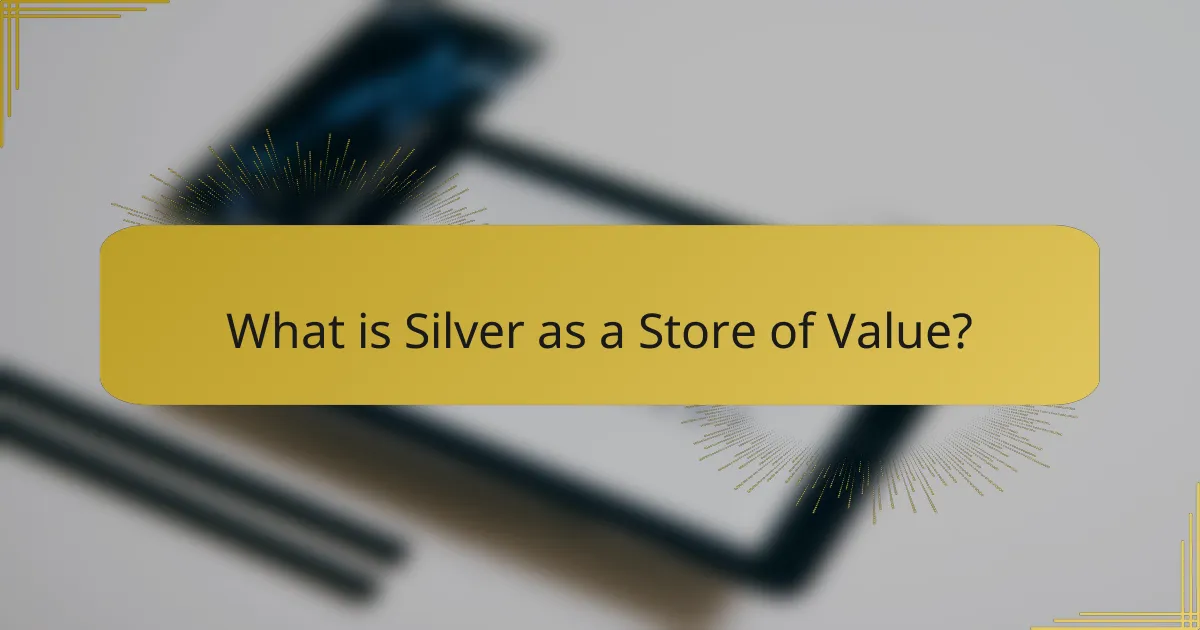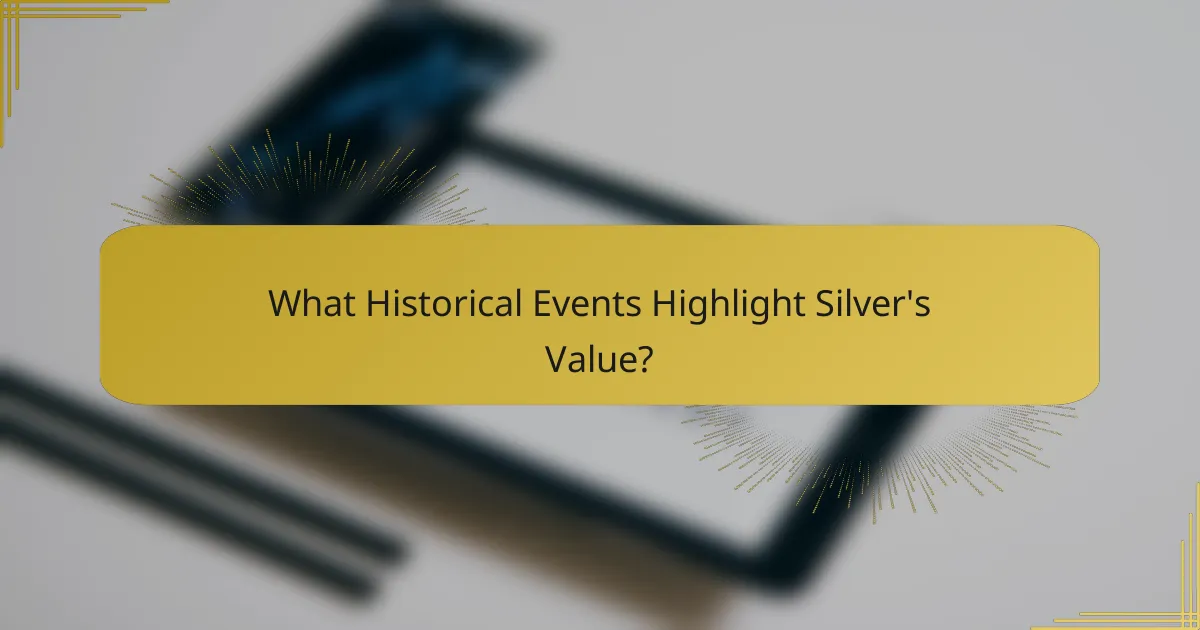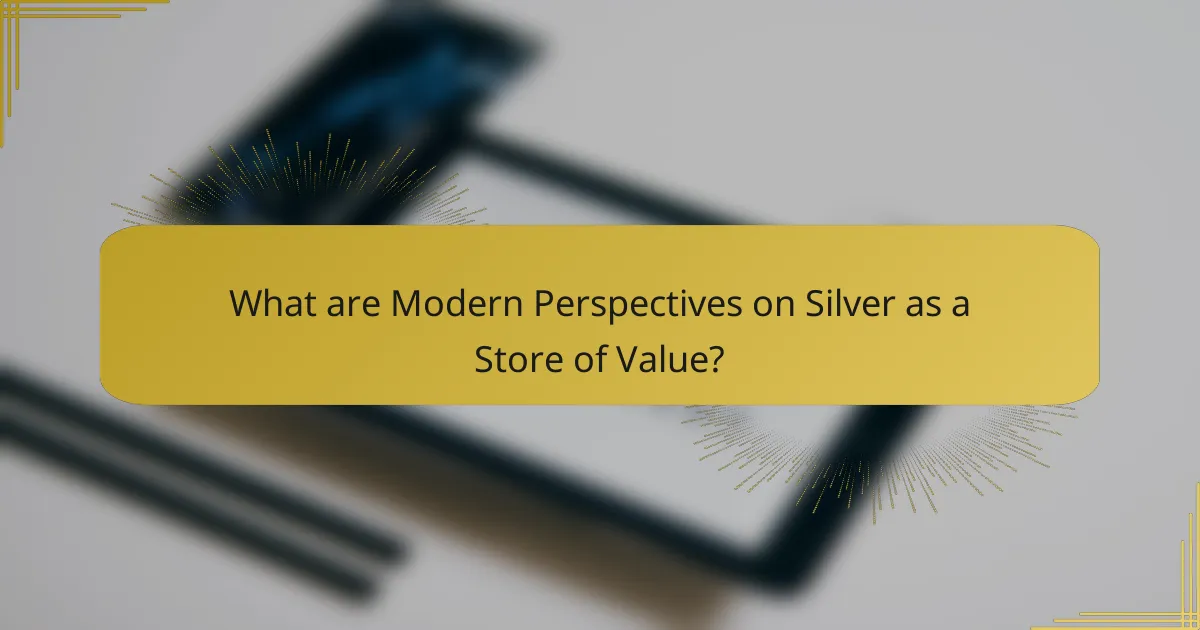Silver is a precious metal historically recognized as a store of value and a hedge against inflation. Its intrinsic value arises from its rarity and demand across various industries, making it a safe haven asset during economic downturns. The article explores silver’s historical significance, including its role as currency during the Spanish conquest and the California Gold Rush, as well as its establishment as a standard for currency in the 19th century. Modern perspectives highlight silver’s increasing demand, particularly during financial crises, and its dual role as both an investment and an industrial commodity, reinforcing its status as a reliable store of value.

What is Silver as a Store of Value?
Silver is a precious metal recognized as a store of value. It has been used for centuries as a form of currency and a hedge against inflation. Silver’s intrinsic value comes from its rarity and demand in various industries. Historically, it has maintained purchasing power over long periods. For example, during economic downturns, investors often turn to silver for protection. In 2020, silver prices surged due to increased market volatility and economic uncertainty. This trend highlights its role as a safe haven asset. Additionally, silver’s physical form allows for easy storage and transfer, enhancing its utility as a store of value.
How has silver been perceived throughout history?
Silver has been perceived as a symbol of wealth and value throughout history. In ancient civilizations, silver was used as currency and a medium of exchange. The Egyptians valued silver for its rarity and beauty, often using it in jewelry and ceremonial objects. In Mesopotamia, silver was standardized as a unit of trade, facilitating commerce. The Romans utilized silver coins, which became a cornerstone of their economy. During the Middle Ages, silver was a key component in minting coins across Europe. In the Americas, the discovery of silver mines significantly impacted economies and trade networks. Today, silver is still considered a valuable asset and is used in various industries, including electronics and jewelry.
What cultures historically valued silver as a currency?
Many cultures historically valued silver as a currency. The ancient Greeks used silver coins known as drachmas. The Romans also minted silver coins called denarii, which became widely used across their empire. In China, silver was utilized as currency during the Tang and Song dynasties, often in the form of ingots. The Spanish Empire valued silver significantly, especially from their mines in the Americas, leading to the global trade of silver. In India, silver coins were used as currency for centuries, notably during the Mughal Empire. These examples illustrate the widespread historical significance of silver as a medium of exchange across various cultures.
How did the role of silver evolve in ancient economies?
Silver evolved from a mere commodity to a key currency in ancient economies. Initially, silver was valued for its beauty and utility in jewelry and artifacts. Over time, societies began to mint silver into coins, facilitating trade. The first known silver coins appeared in Lydia around 600 BCE. This development standardized value and simplified transactions. Silver became a preferred medium of exchange due to its divisibility and durability. Ancient civilizations, such as the Greeks and Romans, relied heavily on silver for economic stability. The use of silver as a store of value solidified its role in commerce and wealth accumulation across cultures.
Why is silver considered a reliable store of value?
Silver is considered a reliable store of value due to its historical significance and intrinsic properties. It has been used as currency and a medium of exchange for thousands of years. Silver’s scarcity contributes to its value, as it is less abundant than many other metals. The metal is also durable and resistant to corrosion, ensuring its longevity as a physical asset. Furthermore, silver has industrial applications that support its demand. According to the World Silver Survey, global silver demand reached 1.03 billion ounces in 2021, highlighting its ongoing relevance. These factors combine to establish silver as a trusted asset for preserving wealth over time.
What intrinsic properties of silver contribute to its value?
Silver possesses intrinsic properties that significantly contribute to its value. Its high conductivity makes it an excellent material for electrical applications. Silver’s resistance to corrosion ensures its durability over time. The metal’s malleability allows it to be shaped into various forms without breaking. Additionally, silver has antimicrobial properties, making it valuable in medical applications. Its rarity compared to other metals enhances its desirability. Historically, silver has been used as currency, further solidifying its status as a store of value. These attributes collectively underpin silver’s enduring worth in various markets.
How does silver compare to other forms of value storage?
Silver serves as a reliable form of value storage, comparable to gold and real estate. Historically, silver has been used as currency and a hedge against inflation. It has intrinsic value due to its industrial applications and limited supply. Unlike fiat currencies, silver retains purchasing power over time. The historical price of silver shows resilience during economic downturns. In contrast, stocks can be volatile, while real estate requires maintenance. Silver’s liquidity allows for easy conversion to cash. Thus, silver is a stable asset for diversifying investment portfolios.

What Historical Events Highlight Silver’s Value?
The discovery of silver in the Americas during the 16th century significantly increased its value. The Spanish conquest of the Aztec Empire led to vast silver mines in Mexico. This influx of silver into Europe fueled economic growth and trade. The 19th-century California Gold Rush also highlighted silver’s importance. Miners often found silver alongside gold, increasing its market presence. The establishment of the Silver Standard in the 19th century further emphasized its value. Countries like the United States adopted silver as a basis for currency. The 1930s Great Depression saw silver prices rise due to its perceived safety. Historical events like these showcase silver’s enduring role as a valuable asset.
How did the discovery of silver mines impact economies?
The discovery of silver mines significantly boosted economies by increasing the availability of currency. This influx of silver enhanced trade and commerce, facilitating economic growth. Regions with silver mines experienced population growth due to job opportunities. For example, the discovery of the Potosí silver mine in Bolivia in the 16th century led to a massive influx of wealth. This wealth contributed to the Spanish Empire’s expansion and increased its global influence. Additionally, silver became a key medium of exchange in international trade. The increased silver supply also caused inflation in some areas, impacting economic stability. Overall, the discovery of silver mines transformed local and global economies through enhanced trade and wealth distribution.
What were the economic consequences of the Spanish silver influx?
The economic consequences of the Spanish silver influx included inflation and shifts in global trade dynamics. The massive influx of silver from the Americas led to a devaluation of currency in Spain. This inflation affected prices of goods and services, making them more expensive. The increased silver supply also disrupted European economies, as it altered trade balances. Spain experienced a short-term economic boost, but long-term consequences included economic decline. The reliance on silver revenues weakened Spain’s industrial development. Additionally, the influx shifted trade routes and increased competition among European powers. This resulted in a more interconnected global economy.
How did silver influence trade routes and global commerce?
Silver served as a critical medium of exchange in global trade routes. Its high demand in various cultures facilitated extensive trade networks. The discovery of silver mines, particularly in the Americas, significantly boosted its availability. This influx of silver altered trade dynamics, allowing for increased commerce between Europe, Asia, and the Americas. Silver became a standard currency, promoting trade efficiency. It also influenced the balance of trade, as countries sought to acquire silver to enhance their economic power. Historical records indicate that the Spanish Empire’s wealth from silver mining transformed European economies in the 16th century. Silver’s role in trade established it as a vital asset in global commerce.
What role did silver play in major economic crises?
Silver served as a critical monetary asset during major economic crises. It acted as a hedge against inflation and currency devaluation. For instance, during the Great Depression, many people turned to silver as a reliable store of value. Historical data shows that silver prices surged in times of financial instability. In the 1970s, silver experienced a dramatic rise due to economic uncertainty and inflation. The Hunt brothers’ attempt to corner the silver market in 1979 exemplified silver’s perceived value during crises. Silver’s liquidity and intrinsic value made it a favored choice in turbulent economic times. Overall, silver has consistently played a significant role in preserving wealth during periods of economic distress.
How did silver serve as a hedge during inflationary periods?
Silver has historically served as a hedge during inflationary periods by maintaining its value when currency purchasing power declines. As inflation rises, the value of fiat currency often decreases. Investors turn to silver as a tangible asset that retains value. For example, during the 1970s inflation in the United States, silver prices surged significantly. Between 1971 and 1980, silver’s price increased from around $1.29 to over $50 per ounce. This price increase reflects silver’s ability to protect wealth against inflation. Additionally, silver’s intrinsic value and limited supply contribute to its effectiveness as a hedge. Silver’s role as a safe haven is supported by its historical performance during economic downturns.
What historical examples illustrate silver’s stability during market downturns?
Silver has historically demonstrated stability during market downturns. For instance, during the 2008 financial crisis, silver prices initially fell but quickly rebounded. By the end of 2008, silver had increased in value as investors sought safe-haven assets. In the 1970s, amid economic instability and inflation, silver prices surged significantly, showcasing its role as a reliable store of value. Historical data indicates that during periods of recession, the demand for silver often rises as investors look for alternatives to traditional currencies. This pattern has been observed consistently, affirming silver’s resilience in turbulent economic times.

What are Modern Perspectives on Silver as a Store of Value?
Modern perspectives on silver as a store of value emphasize its role as a hedge against inflation and economic instability. Investors view silver as a tangible asset that retains purchasing power over time. The metal’s historical significance as currency enhances its appeal. Current market trends show increased demand for silver, particularly during financial crises. In 2020, silver prices surged by over 40% amid global economic uncertainty. This trend indicates a growing recognition of silver’s stability compared to fiat currencies. Additionally, silver’s industrial uses contribute to its value, further diversifying its appeal as an investment. Overall, modern views position silver as a reliable and versatile store of value in uncertain times.
How is silver viewed in today’s investment landscape?
Silver is viewed as a hedge against inflation and economic uncertainty in today’s investment landscape. Investors often turn to silver during periods of market volatility. The metal has historically maintained its value over time. In 2023, silver prices fluctuated between $20 and $30 per ounce, reflecting investor interest. Silver also serves as an industrial metal, increasing its demand in technology and renewable energy sectors. According to the Silver Institute, global silver demand reached 1.2 billion ounces in 2022. This multifaceted demand enhances silver’s appeal as a long-term investment. Many financial advisors recommend allocating a portion of portfolios to silver for diversification.
What factors influence current silver prices?
Current silver prices are influenced by several key factors. Supply and demand dynamics play a crucial role. When demand for silver increases, prices typically rise. Conversely, if supply outpaces demand, prices tend to fall.
Economic conditions also significantly impact silver prices. During economic uncertainty, investors often seek silver as a safe haven, driving up its price. Additionally, inflation rates can affect silver’s appeal as a hedge against currency devaluation.
Market speculation is another important factor. Traders’ perceptions and actions can lead to price volatility. Furthermore, industrial demand for silver, particularly in electronics and solar panels, influences its market value.
Geopolitical events can create market instability, affecting silver prices. Lastly, currency strength, particularly the US dollar, inversely correlates with silver prices; a weaker dollar often leads to higher silver prices.
How do modern investors utilize silver in their portfolios?
Modern investors utilize silver as a hedge against inflation and economic uncertainty. They allocate a portion of their portfolios to silver to diversify their assets. Silver often retains value during market volatility. Investors can purchase physical silver, such as coins or bullion. They also invest in silver exchange-traded funds (ETFs) for liquidity and ease of trading. Additionally, silver mining stocks are another investment avenue. Historical data shows that silver has maintained purchasing power over time. In 2020, silver prices surged by 47% amid global economic concerns, reinforcing its role as a safe haven.
What are the practical considerations for investing in silver?
Investing in silver requires careful consideration of several practical factors. First, assess the current market price of silver, which fluctuates based on supply and demand. As of October 2023, silver prices are around $25 per ounce. Next, consider the forms of silver available for investment, such as coins, bars, and ETFs. Each form has different liquidity and storage requirements.
Evaluate the costs associated with purchasing silver, including premiums over spot prices and shipping fees. Additionally, storage is crucial; physical silver needs secure storage to prevent theft or damage. Tax implications should also be reviewed, as selling silver can incur capital gains taxes.
Finally, understand the historical performance of silver as an investment. Silver has shown resilience during economic downturns, often serving as a hedge against inflation. In 2020, silver prices surged by over 40%, highlighting its potential as a valuable asset.
What types of silver investments are available to individuals?
Individuals can invest in several types of silver. These include physical silver in the form of coins and bars. Silver ETFs (Exchange-Traded Funds) offer a way to invest without holding physical silver. Silver mining stocks provide exposure to the silver market through companies that extract silver. Silver mutual funds allow individuals to invest in a diversified portfolio of silver-related assets. Silver certificates represent ownership of silver without physical possession. Each type offers unique benefits and risks associated with silver investment.
How can investors assess the quality and authenticity of silver?
Investors can assess the quality and authenticity of silver by examining its purity and physical characteristics. The most common standard for silver purity is 925, indicating 92.5% silver content. Investors should look for hallmarks or stamps on silver items that confirm this purity. A reputable assay mark from a recognized authority also verifies authenticity.
Additionally, investors can perform tests such as the magnet test, as silver is not magnetic. The weight test can also help; genuine silver is denser than many other metals. Using a silver testing kit provides a more accurate assessment of purity.
Market prices can serve as a benchmark; if a silver item’s price significantly deviates from current market values, it may indicate inauthenticity. Historical data shows that counterfeit silver products have increased, making these assessments essential.
What best practices should investors follow when considering silver?
Investors should conduct thorough research before investing in silver. Understanding market trends is crucial. Investors should analyze historical price movements of silver. This analysis can provide insights into potential future performance. Diversification is also a key practice. Silver should not be the sole investment. Investors should consider combining silver with other assets. This strategy can reduce overall risk.
Monitoring geopolitical and economic factors is important. These elements can significantly impact silver prices. Investors should stay informed about supply and demand dynamics. Changes in mining production can affect availability. Additionally, considering different forms of silver is beneficial. Physical silver, ETFs, and mining stocks each have unique attributes.
Establishing a clear investment goal is essential. Investors should define their time horizon and risk tolerance. This clarity can guide their investment strategy. Regularly reviewing the investment portfolio is also recommended. Adjustments may be necessary based on market conditions.
Silver is a precious metal recognized as a reliable store of value, historically used as currency and a hedge against inflation. The article explores silver’s intrinsic value, its historical significance across various cultures, and its evolution as a key economic asset. It highlights silver’s stability during economic downturns, its role in modern investment strategies, and practical considerations for investing in silver, including types of investments and best practices for assessment. Additionally, the article discusses factors influencing current silver prices and its ongoing relevance in today’s financial landscape.